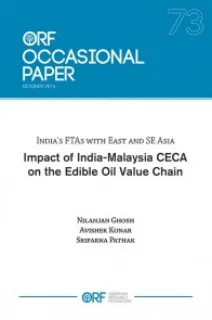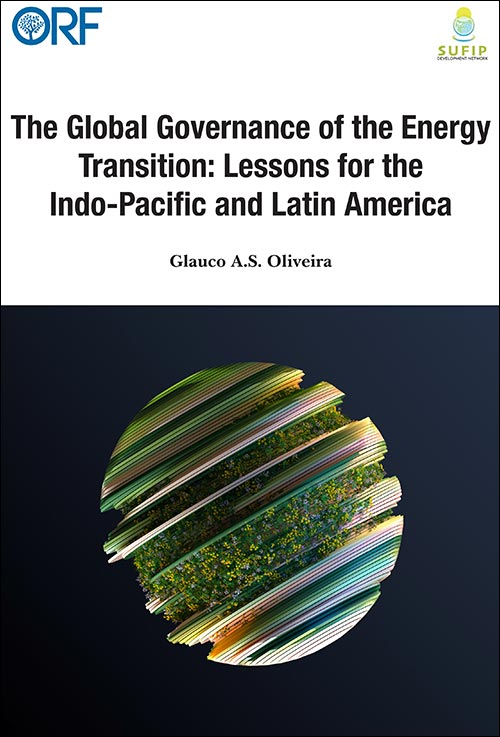Globalisation has increased the flow of trade across many parts of the world and, with it, carries a more contemporary framework for prosperity. Freetrade policies open up previously closed areas to competition and innovation, helping pave the way for more jobs, newer markets and increased investment. Cooperation in international trade through free trade between nations is deemed to be "Pareto Improving"¹ for the participating nations. This concept has been prevalent in the writings of classical political economists like Adam Smith; David Ricardo, in particular, introduced the idea of 'comparative advantage' in international trade.
In India, self-sufficiency through domestic production was for a long time viewed as the appropriate economic strategy, as increased imports were perceived to put a strain on the trade balance and the national exchequer. It is with this idea that initiatives like the Technology Mission on Oil seeds and market intervention operations of National Dairy Development Board (NDDB) were initiated.² However, economic liberalisation in the 1990s pushed India towards becoming a more integral player in the international market.
Eventually, East Asia began emerging as India's principal trade partner, leaving traditional partners like the US and Europe far behind. India has since signed six Free Trade Agreements (FTAs) with the East and Southeast Asian regions. FTAs generally entail arrangements between two or more countries or trading blocs to reduce or eliminate customs tariffs and non-tariff barriers. Amongst these agreements, deserving of particular mention are India's Comprehensive Economic Partnership Agreement (CEPA) with South Korea, and the India-Japan Comprehensive Economic Partnership Agreement (IJCEPA).³ Similarly, the Association of Southeast Asian Nations (ASEAN)-India Free Trade Agreement (AIFTA) has ushered India along the path of greater integration with East and Southeast Asia. (See Appendix for Definitions of the various trade pacts.)
Does India benefit from these FTAs? Viewed through the prism of balance of payment/trade (BoP/T), the answer is quite unequivocal: India has not benefitted from the FTAs, or in trade of commodities where tariff regimes have been too liberal. Available data suggest that in case of most of the FTAs with the east and southeast Asian nations, India's bilateral BoP/T deteriorated after signing of the FTAs, as Indian imports increased faster than exports with the corresponding counterpart economy. From a macroeconomic perspective, this has been perceived as a negative development by many.
Negative BoP/T numbers, however, should not be the only metric of social welfare to be examined by policy-makers. In the context of FTAs, adverse BoP/T figures could be the result of higher elasticity in import demand which, in India, in fact helped increase the consumer surplus. This in turn implies that consumers might have benefited from the FTAs, or a liberalised tariff and non-tariff barrier regime.
There is substantial literature on India's FTAs with other nations. Most of the studies are concerned with impacts on broad macro-variables. In 2013 the Federation of Indian Chambers of Commerce (FICCI) conducted a survey, titled Business Beyond Barriers, to ascertain factors impacting trade and investments between India and ASEAN, and determine the effect of India- ASEAN FTA on the Indian industry. The survey showed that half of the respondents feel that the FTA in goods has had either no impact or an adverse impact on the trade balance.
Many other analysts perceive FTAs positively from other dimensions. Babu (2012), for one, discusses the India-Japanese CEPA and sees it as a tool of strengthening bilateral trade relations. Das (2014) calls the CEPA between India and Japan a 'negotiating template', and Mehta (2005) discusses the various kinds of non-tariff barriers imposed by Japan on non-agricultural products. Yet most of these studies are limited to understanding the trade balance of India vis-à-vis its trading partner. Sen (2013), while exploring the trade pact with South Korea, states that the India-Korea FTA helped India increase its presence in the region. Similarly, Wignaraja (2014) examines the gains for South Asian economies from integrating with East Asia and India's role in the process, and proposes a case for further integration. At a global level, Toledo (2004)¹¹ uses specific factors (SF) model of productivity and trade to examine the potent impact of FTAA on Peru's output and wages. This leads us to analysing some of the research questions of the present paper on the impact of FTAs on commodity value chain such as those of farmers, consumers, labour and producers.
In line with Toledo's work, Pal and Dasgupta (2008)¹² argue that though India might not benefit in the short run from the FTA with ASEAN, the agreement may make strategic sense in the long run especially if India wishes to become a hub for services' exports. Contrary to what is posited by Pal and Dasgupta (2008), Asher and Sen (2008)¹³ argue that India's unilateral liberalisation policies since the early 1990s, and its purposeful and strategic pursuit of its Look East Policy, have resulted in integration with the rest of Asia more considerable than is commonly acknowledged.
There are several ex post empirical studies of FTAs. A popular class of models in this literature, using international trade flows, are the gravity models developed by Tinbergen (1962) and Poyhonen (1963). The basic idea-borrowed from Newton's laws of universal gravitation-is that the Flow of ideas, information, trade, and people between two locations is directly proportional to their size (GDP of the individual country) and inversely proportional to the distance. A multiplicative model can be linearised easily by taking the natural logarithms and is amenable to standard econometric estimation techniques. These papers use a dummy variable to estimate the impact of FTAs and the resultant trade creation. For instance, Aitken (1973) uses variables like gross trade creation (GTC), trade diversion (TD), and external trade creation (ETC) as measures of economic integration-induced trade between member countries utilising a cross-sectional trade flow model. Ghosh and Yamarik (2004) used extreme bounds analysis and tested the robustness of the coefficient estimates, and found the coefficients estimating the effects of RTAs on trade creation to be 'fragile'.
As the literature survey in the previous paragraph reveals, most of the analyses of the impacts of FTAs have been conducted looking at the macrolevel impacts, and there hardly exists any study that has looked at sectoral impacts, barring one by Srinivasan (2012) that considers a computable general equilibrium (CGE) framework.
There is a clear gap in the literature in the context of the impacts of FTA or tariff liberalisation (or removal of non-tariff barriers) on the commodity value chain. The need is to assess their aggregate impacts considering the entire value chain, beginning from the consumer, entrepreneur, primary producer, processor, intermediaries, distributors, retailers and the government (as a zero-tariff regime impacts government's revenue). This implies a need to take a holistic view for the impact assessment of tariff regime changes, as the trade regime moves from high tariffs to zero tariff. This framework will allow for a better assessment and more informed decisionmaking on tariff regime changes.
This paper is an attempt to proffer the notion that there are alternative metrics, other than BoP/T, that need to be evaluated to calculate the wellbeing of various stakeholders. This methodology can be gainfully employed in assessing other FTAs involving different commodities. This paper carries out a disaggregated analysis of how the various stakeholders' benefits are affected by changes in tariff regime. Of course, removal of non-tariff barriers is also associated with FTAs. However, in this paper, the concern is with the tariffs, and a proposal is made for a framework that can be extended for evaluation of removal of non-tariff barriers as well.
This paper takes a close look, in particular, at the edible oil sector and considers the major links of edible oil value chain in the context of the India- Malaysia CECA. The India-Malaysia CECA is chosen for analysis as Malaysia is the largest producer and exporter of palm oil in the world. Ever since India opted for zero-tariff for crude palm oil (CPO) and reduced the tariff to 7.5 percent for refined palm oil, imports of palm oil to India from Malaysia increased manifold (See Figure 7). More importantly, palm oil imported from Malaysia now constitutes around 45-50 percent of the total edible oil consumption in India in this decade, having grown from seven percent in 1994. This massive change is envisaged to have tremendous impact on the edible oil value chain participants-positively on some, and negatively on others. This paper attempts to conduct a systematic analysis of these impacts on the commodity value-chain. However, it is pertinent to state that the zerotariff regime reduces the price of the imported edible oil for the consumers, and prove to be competitive for the domestically produced edible oil. As such, import duty on all crude and refined edible oils were reduced to zero percent and 7.5 percent, respectively, in April 2008, before the India-Malaysia CECA was signed in June 2011. Hence, the tariff impact (as is prevalent for FTAs) was already perceptible when the India-Malaysia CECA was signed.
In its endeavour to track impact, this study uses a mathematical economic model (to provide the theoretical explanation of welfare changes of various stakeholders), an econometric framework through a simultaneous equation system to obtain tariff elasticities of various variables, and a counter-factual framework or a scenario analysis through hypothetical tariff structures to present the sensitivity of the various variables to tariff changes. A partial equilibrium framework is propounded to link the edible oil sector with the oilseed sector, and examine the impact of tariff reduction (or increase) on the well-being of various stakeholders of the value chain, namely, consumers (through consumer surplus), processors (through producer surplus), labour or employment (through wage-bill), farmers (through farmers' surplus), and government (through revenue generated). The sum of the changes in consumer surplus is considered, as well as producer surplus, farm income from the supply of oil seeds, wage bill and government revenue. The change in this total amount (social surplus) because of changes in the tariff regime, is also studied. This provides a better metric of social welfare, as it concerns all the important participants in the value chain-from the consumers, and producers in the output market to the suppliers in the factor market, labour, and lastly the government which has the authority to impose the tariff, and to potentially redistribute the revenue earnings for the overall benefit of society. The paper therefore attempts to contribute to the existing studies evaluating the outcomes of the FTAs particularly for a single commodity import dominant trade basket. While this paper offers an analysis that considers the edible oil value chain, it also creates a replicable value chain impact study for other commodities.
Section II of this paper presents a brief picture of India's various FTAs with East and Southeast Asia, and their consequent impacts on the balance of trade for India in the bilateral framework. Section III describes the state of India's edible oil economy and relates the changes occurring there with the tariff liberalisation policies. Section IV provides for the mathematical economic model to create the theoretical basis for this paper. In the process, this paper also talks of a comparative static framework, to understand how the tariff (or domestic price) changes of edible oils percolate across various other sectors including processing industry, and oilseed farmers. Section V presents the econometric methodology, estimates, scenario analysis, and a discussion of the results. The paper concludes with Section VI, examining the policy and academic significance of this study and raising relevant policy questions.

 PDF Download
PDF Download



 PREV
PREV




.png)